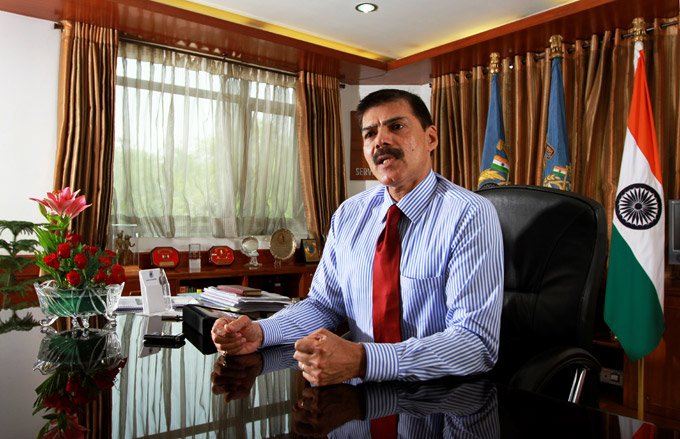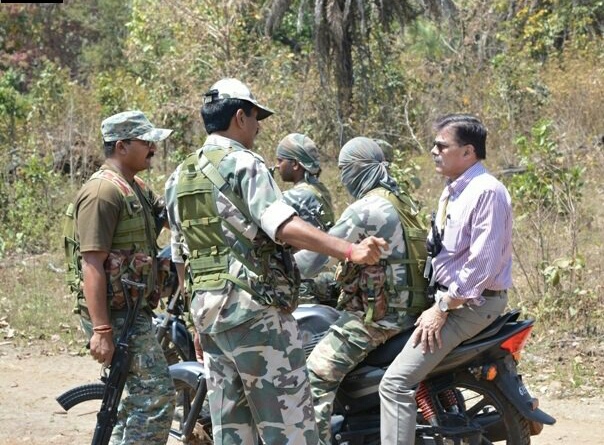K. Vijay Kumar (IPS retd), is a former Director General of India’s Central Reserve Police Force (CRPF) and was Chief of the Special Task Force that brought down the notorious sandalwood smuggler Veerappan in difficult jungle terrain during Operation Cocoon in 2004. He has also been head of the Sardar Vallabhbhai Patel National Police Academy, Hyderabad, in the past. Widely regarded as an authority on counter-insurgency, Mr Kumar is currently Senior Security Adviser to India’s Ministry of Home Affairs (MHA). Delhi Defence Review’s, Chandrashekhar Bhattacharyya, caught up with him to discuss the progress of the MHA’s operations against Maoist insurgents in Central India.
CB: What progress has been made in the setting up of the ‘Bastariya Battalion’, which is supposed to be composed of local tribal recruits?
VK: It’s only the locals – that too, from Bastar. This is also the first battalion in the country which meets the 33 percent women component norm.
CB: Will the Bastariya Battalion be a full-fledged CRPF battalion or will a part of its cost be borne by the Chattisgarh State government?
VK: Fully CRPF. That is, Government of India. No state funds.
CB: What will be the employment paradigm for this Unit?
VK: At least for the first few years, it will be in Bastar. Later, it may be deployed, may be, elsewhere. That depends on how the IS – Internal Security situation evolves in various parts of the nation.

CB: The Indian Army is setting up a new cantonment outside Raipur. Will this lead to greater Army involvement in the training of Central Armed Police Forces (CAPFs) deployed in the area or will the Army presence merely serve as a psychological bulwark?
VK: If just an Army cantonment comes up, more inter-force synergy would result, but it would be just a psychological bulwark. But if an Army training Unit were to come up, then the benefits would be greater.
CB: How would you rate the performance of the ITBP and BSF units inducted into the fight against Left-wing Extremism (LWE)? Have they adapted well to their new surroundings?
VK: I would rate their performance as Outstanding. ITBP handles Rajnandgaon at the MP-Chattisgarh-Maharashtra tri-junction as well as another spot in Kondaigaon – which is a gateway to Bastar. The BSF handles Kanker district, including the Rawghat mines which is now being developed. Both these Forces have adapted extremely well. (The CRPF handles the rest – including the more sensitive Dandakaranya.)
CB: It’s believed that CPI (Maoist) commanders and cadre frequently visit urban areas. Do you foresee a future, wherein, under tremendous pressure from CAPFs in the jungle, the CPI (Maoist) tries to morph into an urban insurgent organization, looking to take advantage of vast concrete sprawls?
VK: Already they have their urban and semi-urban safe-havens. When there is too much pressure, it is only natural that while the cadres will move to safer jungles, the top leadership would in turn migrate to towns and urban centres.
CB: What should India’s policy on CPI (Maoist) over-ground workers be, going forward?
VK: As long as over-ground workers do not propagate armed violence and do not fund people indulging in violence, but only take up the case of the ‘dispossessed’, ‘tribal’ etc, one can be tolerant. There are many different models of anti-terrorism laws – UK, Israel, USA and our own UAPA. As regards what is just ‘support’ and active assistance/collusion, some of these can be our guide posts.
CB: Should anti-Maoist operations /Anti-Naxal operations start focusing even more on small unit strikes, rather than large unwieldy area domination patrols?
VK: Small Team Ops are great but cannot be a standard fix. Small teams can be effective in certain areas of the LWE theatre. It is not that advisable in a place like Bastar. There it should be a combination of large-scale and small team ops. More than small, the apt word would be ‘sleek’, meaning tactically-savvy jungle troops. In untamed turf, ‘domination patrols’ are like flag marches trying to tell the public in a loud voice that, ‘we ( the govt.) are here’. However, there are unavoidable open movements – like a road opening, road construction, supply convoys to own troops or an open visit to a village for an express purpose. All these have to be carried out mostly in daylight, openly but with sufficient care. Globally, the most successful counter-insurgency (CI) ops have been done by troops which silently, stealthily induct and extract. Once, the insurgents are sufficiently controlled and the public starts tilting towards the Counter Insurgents, then at that stage, more transparent movement of troops would be in order.
CB: Would you concede that there are training gaps that lead to tragedies such as the recent loss of 24 CRPF personnel in Sukma?
VK: Post incident-analysis, even of the successful ones, always reveal gaps which could have been better exploited by either side. We lost ‘X’ many because of this, this, etc. We got ‘Y’ many of them, but could have got ‘Z’ many, had we …. …. , etc. Having said that, in a big incident like the one you mentioned here, there must have been some gaps which have been analysed and are being addressed. Fatigue and tedium of troops posted in remote areas for indefinite periods is a major morale-sapper, which too is being addressed. It is for sure, that part of Bastar, is the most difficult, for any SF, anywhere in India today.
© Delhi Defence Review. Reproducing this content in full without permission is prohibited.
































